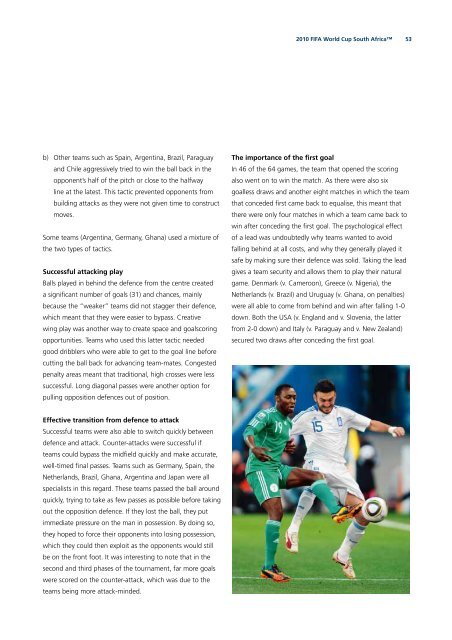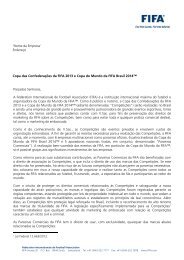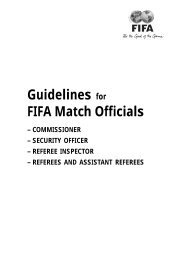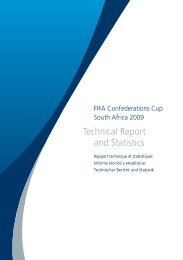You also want an ePaper? Increase the reach of your titles
YUMPU automatically turns print PDFs into web optimized ePapers that Google loves.
) Other teams such as Spain, Argentina, Brazil, Paraguay<br />
and Chile aggressively tried to win the ball back in the<br />
opponent’s half of the pitch or close to the halfway<br />
line at the latest. This tactic prevented opponents from<br />
building attacks as they were not given time to construct<br />
moves.<br />
Some teams (Argentina, Germany, Ghana) used a mixture of<br />
the two types of tactics.<br />
Successful attacking play<br />
Balls played in behind the defence from the centre created<br />
a signifi cant number of goals (31) and chances, mainly<br />
because the “weaker” teams did not stagger their defence,<br />
which meant that they were easier to bypass. Creative<br />
wing play was another way to create space and goalscoring<br />
opportunities. Teams who used this latter tactic needed<br />
good dribblers who were able to get to the goal line before<br />
cutting the ball back for advancing team-mates. Congested<br />
penalty areas meant that traditional, high crosses were less<br />
successful. Long diagonal passes were another option for<br />
pulling opposition defences out of position.<br />
Effective transition from defence to attack<br />
Successful teams were also able to switch quickly between<br />
defence and attack. Counter-attacks were successful if<br />
teams could bypass the midfi eld quickly and make accurate,<br />
well-timed fi nal passes. Teams such as Germany, Spain, the<br />
Netherlands, Brazil, Ghana, Argentina and Japan were all<br />
specialists in this regard. These teams passed the ball around<br />
quickly, trying to take as few passes as possible before taking<br />
out the opposition defence. If they lost the ball, they put<br />
immediate pressure on the man in possession. By doing so,<br />
they hoped to force their opponents into losing possession,<br />
which they could then exploit as the opponents would still<br />
be on the front foot. It was interesting to note that in the<br />
second and third phases of the tournament, far more goals<br />
were scored on the counter-attack, which was due to the<br />
teams being more attack-minded.<br />
<strong>2010</strong> <strong>FIFA</strong> World Cup South Africa<br />
The importance of the fi rst goal<br />
In 46 of the 64 games, the team that opened the scoring<br />
also went on to win the match. As there were also six<br />
goalless draws and another eight matches in which the team<br />
that conceded fi rst came back to equalise, this meant that<br />
there were only four matches in which a team came back to<br />
win after conceding the fi rst goal. The psychological effect<br />
of a lead was undoubtedly why teams wanted to avoid<br />
falling behind at all costs, and why they generally played it<br />
safe by making sure their defence was solid. Taking the lead<br />
gives a team security and allows them to play their natural<br />
game. Denmark (v. Cameroon), Greece (v. Nigeria), the<br />
Netherlands (v. Brazil) and Uruguay (v. Ghana, on penalties)<br />
were all able to <strong>com</strong>e from behind and win after falling 1-0<br />
down. Both the USA (v. England and v. Slovenia, the latter<br />
from 2-0 down) and Italy (v. Paraguay and v. New Zealand)<br />
secured two draws after conceding the fi rst goal.<br />
53







